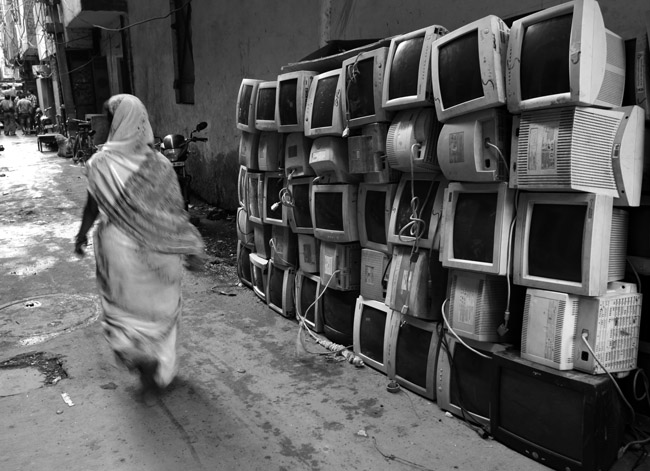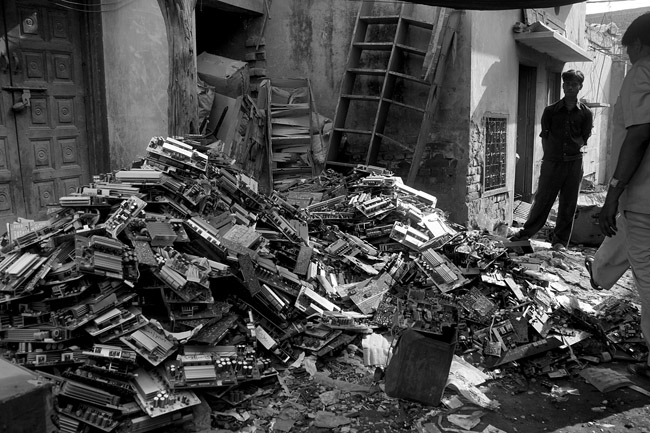Fifteen-year-old Masood, who loiters in the streets of Mustafabad in east Delhi on days when he is not working, jocularly calls himself a reverse engineer. His job is to dismantle computers. He does many every day, knowing little that the toxins present in the hardware of these dead machines is killing him slowly.
With no protective gears, Masood and his friends burn circuit boards and cables to extract precious metals like gold, lead, copper and platinum in poorly ventilated rooms, inhaling dangerous and slow-poisoning chemicals. Safety gear such as gloves, face masks and ventilation fans are virtually unheard of, and children like masood often have little idea of what they are handling. The toxins released in the process of separating these metals can damage the kidneys, the brain and the lungs. Skin diseases, hormonal imbalances, asthma and even cancer are caused by these toxins. These chemicals are now a part of the soil and water as well due to landfilling of e-waste.
According to the Union Ministry of Environment and Forests’ own report, India has generated a whooping eight lakh tonnes of waste in the year 2012 alone, marking an eight-fold increase in the last seven years. Despite a ban on importing of e-waste, an additional 50,000 tonnes makes its way in the country through illegal means, thanks to the lax regulation. More than 70% of e-waste in India comes from 10 states of Maharashtra, Tamil Nadu, Andhra Pradesh, Uttar Pradesh, Gujarat, West Bengal, Delhi, Karnataka, Madhya Pradesh and Punjab. Out of the cities, Mumbai is the hub of e-waste in India followed by Delhi, Bangalore, Chennai, Kolkata, Ahmedabad, Hyderabad, Pune, Surat and Nagpur. But the young boys and girls like Masood who are risking their lives for meagre livelihood of this waste are lost in the background of these statistics. They have no social protection or health coverage. In fact, there is so far no information as to how many people are employed in India in this informal sector of e-waste disposal.
We generate 8 lakh tonnes of e-waste every year = 110 million laptops! Bangalore alone generates 400,000 batteries as e-waste every month. There is definitely a better way to dispose the remains of our digital age, than to thrust it, unsorted, in the hands of people who stake their lives and health to extract useful materials out of it.
This article was written & photographed by Chinky Shukla, and was first published in © Tasveer Journal
 Every year eight lakh metric tonnes of e-waste is generated in India. 95% of this is recycled in the informal sector, in the bylanes of cities and towns.
Every year eight lakh metric tonnes of e-waste is generated in India. 95% of this is recycled in the informal sector, in the bylanes of cities and towns.
 An additional 50,000 tonnes of e-waste is imported to India from developed countries despite the import laws which restricts the disposal of e-waste. In the picture the circuit board is burned to extract metals.
An additional 50,000 tonnes of e-waste is imported to India from developed countries despite the import laws which restricts the disposal of e-waste. In the picture the circuit board is burned to extract metals.
 E-waste informal sector workers toiling without any protective gears.
E-waste informal sector workers toiling without any protective gears.
 Computer hardware spills over to the road in Mustafabad.
Computer hardware spills over to the road in Mustafabad.
 A naive young worker inhales toxic fumes as he melts circuit board to extract precious metals.
A naive young worker inhales toxic fumes as he melts circuit board to extract precious metals.
 Minors dismantling old electronic equipment.
Minors dismantling old electronic equipment.
 Eight year old Ashfaq and his brother dip circuit boards in acid to extract metals for a paltry sum of Rs 50-80 daily.
Eight year old Ashfaq and his brother dip circuit boards in acid to extract metals for a paltry sum of Rs 50-80 daily.




